Exploring Brown and Orange Crystals: Nature's Treasures
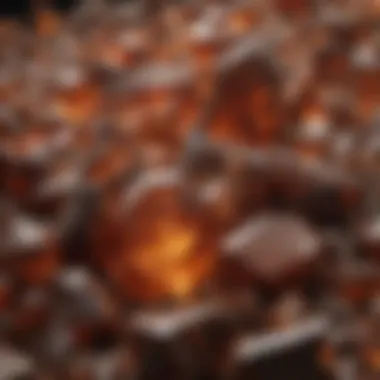
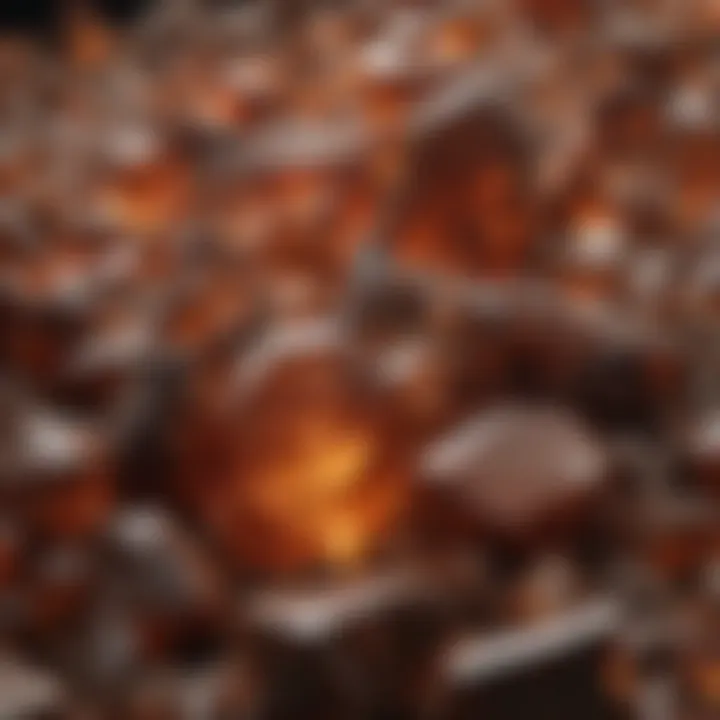
Intro
Brown and orange crystals exhibit a fascinating spectrum of natural beauty. These stunning geological formations captivate collectors and enthusiasts alike with their warm hues and intricate patterns. Ranging from the earthy tones of brown jasper to the vibrant shades of orange calcite, these crystals possess unique characteristics that tell a story about their formation and the environmental conditions that shaped them. Understanding these crystals deepens our appreciation not only for their aesthetic allure but also for their geological significance and cultural context.
This exploration invites you to look beyond the surface of brown and orange crystals, considering their role across various fields such as geology, art, and healing. Whether you are a seasoned collector or a curious newcomer, there is always more to discover about these remarkable gems.
Featured Collectible of the Month
Overview
One crystal that stands out this month is the stunning carnelian. This orange-red variety of chalcedony has been prized for centuries due to its alluring color and smooth texture. Its warm tones can range from deep red to light orange, often exhibiting translucent qualities that catch the light beautifully. This stone has ornamented jewelry and artifacts from different cultures, marking its significance through time.
Historical Significance
The historical significance of carnelian is noteworthy. It has been discovered in ancient burial sites, often associated with protection and the afterlife. In many cultures, including Egyptian and Roman, carnelian was believed to promote courage and creativity, making it a favored stone among craftsmen and artists. Collectors often seek carnelian not just for its striking looks but also for its rich historical backdrop. Its presence in various cultures makes it a tangible link between the past and present.
Identification Techniques
Identifying brown and orange crystals requires a keen eye and the right approach. Below are some effective techniques to help you distinguish between different types of crystals in this color spectrum.
Visual Characteristics
- Color Variation: Assess the shade within the brown or orange spectrum. Is it a deep, earthy tone, or is it bright and fiery?
- Translucency: Examine how light interacts with the crystal. Some brown and orange crystals, like carnelian, may let light through, while others remain opaque.
- Surface Texture: Look for patterns, striations, or inclusions. The texture can hint at the crystal’s unique origin or even its historical use.
Resources for Identification
Utilizing a variety of resources plays a crucial role in identifying these gems accurately. Here are some reliable options:
- Online forums like reddit.com have communities dedicated to rock and mineral collecting where experienced members can provide insights.
- Books and guides on geology can offer detailed descriptions and photos of various crystals.
- Websites such as Wikipedia and Britannica host articles rich with information on specific minerals and their attributes.
"Understanding the nuances of each crystal type can enhance not only your collection but also your appreciation of nature's diversity."
As we gather more information out there, we build a more profound connection with these crystals, seeing them as more than mere objects to collect, but as representations of the earth's intricate history.
Prelude to Brown and Orange Crystals
Brown and orange crystals hold a special place in the mineral kingdom. Their rich hues and unique characteristics make them not just visually appealing but also significant in various aspects of geology, cultural history, and even spirituality. This section serves as a doorway into the world of these fascinating crystals. The interplay of their colors, often associated with the earth itself, draws a deep connection to nature, inviting enthusiasts to explore their meanings and uses.
Defining Crystals and Their Categories
Crystals can be thought of as the building blocks of the mineral world, forming through an intricate dance of elements that crystallize under specific conditions. At a basic level, a crystal is a solid material whose atoms are arranged in a highly ordered structure, creating a repeating pattern that extends in all three spatial dimensions.
Crystals are typically categorized based on their chemical composition and crystal system. For example, among the silicate minerals, which consist primarily of silicon and oxygen, we find quartz. Brown and orange crystals often fall into specific groups, such as quartz, calcite, or topaz, where their color variations are due to the presence of trace elements.
- Silicate Crystals: Including quartz and its varietes.
- Carbonate Crystals: Such as calcite.
- Aluminosilicate Crystals: Like topaz.
Each category reveals a deeper understanding of not only the crystals themselves but also the geological processes that birthed them. Understanding these categories can be crucial for collectors and enthusiasts who seek to appreciate the nuances that define each specimen.
The Visual Appeal of Brown and Orange
The colors brown and orange in crystals can evoke thoughts of warmth and stability. It's fascinating how these hues, often connected with the earth, can also bring a sense of comfort and grounding in a world that sometimes feels chaotic. The visual allure of brown and orange crystals can be attributed to several factors:
- Color Depth: The shades can range from rich burnt umbers to delicate amber, each presenting a unique aesthetic quality that resonates with many collectors.
- Transparency Levels: Some specimens, like smoky quartz, exhibit varying degrees of transparency, enhancing their beauty under sunlight.
- Patterns and Inclusions: Many brown and orange crystals display fascinating patterns or internal inclusions, which can tell a story of their geological journey.
"Crystals are not just stones; they are nature's art - each telling a tale of formation, environment, and time."
This rich visual appeal draws in collectors, artists, and spiritual practitioners alike, as they seek to explore and incorporate these crystals into their lives, whether for decoration, healing, or study. The efficacy of brown and orange crystals is often reflected in their striking appearances, inviting observers to appreciate their beauty while considering the stories they represent.
Geological Formation of Brown and Orange Crystals


When it comes to understanding the allure and significance of brown and orange crystals, one cannot bypass the pivotal role of geological formation. These gems do not merely appear; they are born out of intricate processes that unfold over thousands, if not millions, of years. This section will delve into the mechanisms that give rise to these stunning geological specimens, offering insight that both enthusiasts and collectors would appreciate.
Processes Leading to Crystal Formation
The world of mineralogy is fascinating, particularly when we consider how crystals come into being. The formation of brown and orange crystals often begins deep within the Earth. Heat and pressure play key roles in this process. As magma cools, for instance, minerals begin to crystallize and form solid structures. One might say it’s a slow dance of chemistry and geology.
In other cases, geological events such as volcanic eruptions and metamorphism contribute to the formation of these crystals. The lava cools on the surface, allowing minerals to grow in an orderly fashion. You might find that some crystals are formed from sedimentary processes too, where minerals deposited by water solidify over time, showcasing the beauty of nature’s artistry when exposed to sun, rain, and elements.
Understanding these processes not only enriches the collector’s knowledge but also enhances appreciation for the natural world. The forms and colors of brown and orange crystals are a direct result of these fascinating geological happenings.
Mineral Composition and Colorations
The colors we observe in brown and orange crystals are intimately linked to their mineral composition. Iron oxide is a prime candidate for producing those rich brown hues. It’s interesting to note how slight variations in mineral content can shift the crystal’s shade from a deep earthy tone to a vibrant orange. It’s almost like the rocks are wearing different outfits!
In addition to iron oxide, other minerals contribute to these hues. For example, higher concentrations of manganese can create yellow or orange tones, particularly in quartz. This interplay of elements is what makes each crystal unique; no two pieces will tell the same story.
Crystals vividly illustrate the relationship between chemistry and color, leading many collectors into a thrilling journey of exploration and education. A keen eye for detail—recognizing these color variations based on mineral makeup—can significantly elevate one’s collecting game.
"Every crystal is a unique snapshot of the Earth’s history, capturing moments from its deep geological past."
This keen insight into geological formation not only sets the stage for the captivating story of brown and orange crystals but also underscores their importance in both nature and in human culture.
Common Types of Brown and Orange Crystals
Brown and orange crystals represent a vivid tapestry of nature's creativity. These gems not only have striking visual appeal but also bear significance in various contexts, including industrial applications and personal collections. Understanding the common types of these crystals allows collectors and enthusiasts to appreciate their uniqueness and potential value.
Quartz Varieties: Smoky and Citrine
Quartz is undoubtedly one of the most abundant minerals on Earth, and its varieties, like smoky quartz and citrine, both embody breathtaking hues that catch eyes and stir imaginations.
Smoky quartz, with its subtle brown tones, is often appreciated for its grounding and protective properties. In many spiritual traditions, it is believed to absorb negative energy, making it a popular choice among collectors seeking metaphysical benefits. Often used in jewelry and decorative items, its beautiful translucency can enhance any display.
On the other hand, citrine captures the richness of autumn leaves. Its vibrant yellowish-orange shades can inspire thoughts of warmth and positivity. Known as a stone of abundance, many consider it a favorite among those aiming to attract wealth and prosperity. Both types have distinct characteristics, making them essential inclusions in any collection of brown and orange crystals.
Calcite: A Multifaceted Mineral
Calcite is another fascinating player in the world of brown and orange crystals. This mineral comes in various forms, making it incredibly versatile. Its colors can range from deep amber to light brown, depending on the impurities present during formation.
Calcite is particularly cherished for its optical properties, with many types displaying a phenomenon known as birefringence, which can give the appearance of double images. The ways in which light interacts with calcite crystals create mesmerizing effects that collectors often seek.
In addition, calcite has significant historical importance; it has been used in building materials and artworks for centuries. Collecting calcite not only enriches a visual collection but also connects an individual to a long legacy of human creativity.
Topaz: The Gemstone of Vibrance
Topaz stands out as a magnificent gemstone among the brown and orange crystals. Often associated with clarity and strength, topaz can vary widely in color, including warm hues of orange and brown. This stone is known for its capacity to be cut into various shapes, enhancing its allure for jewelers.
Traditionally, topaz has also been linked to many myths and symbols. In ancient times, it was thought to protect against envy and harm, adding another layer of charm to this captivating gemstone. Topaz is particularly appealing for its beauty and also attracts those who value its deep historical significance. Adding it to a collection represents not only an aesthetic choice but a nod to the rich traditions surrounding this gemstone.
In sum, the common types of brown and orange crystals encompass a variety of unique features and rich histories. Collectors and enthusiasts alike can find beauty and significance within these crystalline forms, each bringing its own story to the table.
Identifying Brown and Orange Crystals
Identifying brown and orange crystals is a crucial step for enthusiasts, whether they are just dabbling in collecting or are seasoned pros. Being able to distinguish these stunning geological formations not only enhances your appreciation for their beauty but also ensures that your collection remains genuine and valuable. It can be both a rewarding and educational experience as you engage your senses and cultivate critical observation skills. Understanding these aspects can make a substantial difference in how one connects with the crystals, leading to a deeper, more meaningful relationship with the natural world.
Visual Characteristics to Observe
When it comes to identifying brown and orange crystals, starting with their visual characteristics is key. These colors can come in many shades and patterns, each telling a story from its geological past. Pay attention to:
- Color Depth: Brown crystals can range from warm, deep hues like umber to lighter tones that almost appear tan. Orange crystals often exhibit a fiery, almost glowing quality, reminiscent of autumn leaves.
- Clarity: Some brown crystals may be clear or translucent, while others are opaque. Analyzing the clarity can give clues about the crystal’s type and its formation history.
- Patterns and Inclusions: Many crystals have unique striations or internal formations that can help in identification. For example, quartz varieties, like smoky quartz, display a smoky translucence, while citrine might present a more vibrant yellowness with orange undertones.
- Lustre: The surface sheen can vary widely, from the glassy finish of quartz to a more matte sheen in some types of calcite. This can also aid in distinguishing between similar-looking crystals.
Ultimately, careful observation has its merits; it's often in the details where distinguishing characteristics come to light.
"The beauty of each crystal is not just in its overall color or shape but in the nuances that tell the story of its journey through time."
Utilizing Tools for Accurate Identification
To elevate your crystal identification skills, arming yourself with the right tools is essential. Here's a list of useful items that can enhance your collecting experience:
- Loupe or Magnifying Glass: To closely examine inclusions, patterns, and surface characteristics.
- Refractometer: This tool can help determine the refractive index of the crystals, which is a reliable method for identification.
- Hardness Tester: By checking the hardness of your crystal on the Mohs scale, you can further narrow down what type you are dealing with.
- Gem Testing Kits: There are kits specifically designed for identifying the composition of stones, which often include a range of useful items.
- Reference Guides or Apps: Having a printed guide or a mobile app that details various crystals can help in comparing your finds against documented specimens.
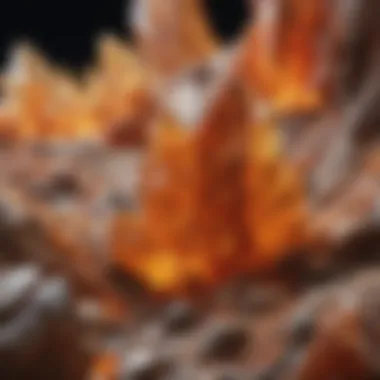
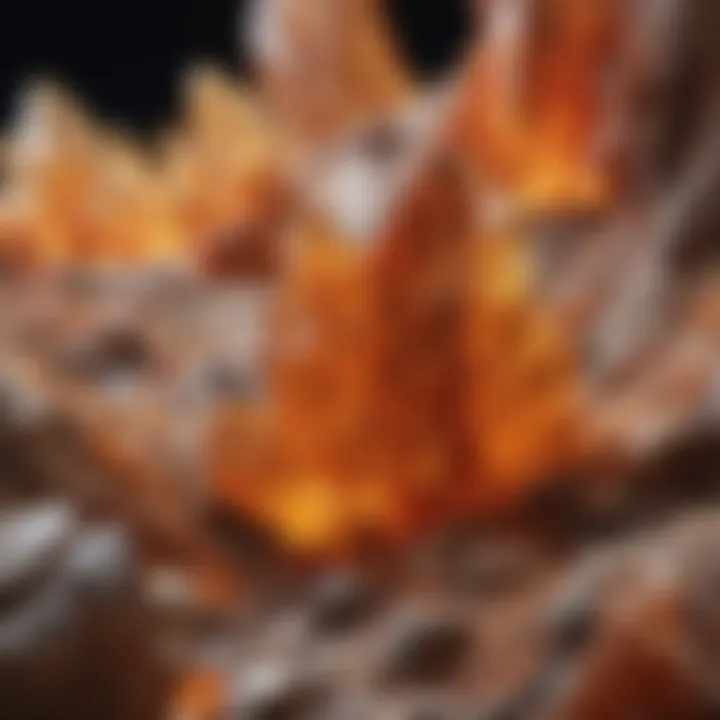
In combining careful observation with the correct tools, collectors increase their accuracy in not only identifying individual specimens but also in appreciating the complexities within their collections. The knowledge gained through these practices lays a strong foundation for any rock and mineral enthusiast.
Cultural Significance of Brown and Orange Crystals
The allure of brown and orange crystals extends far beyond their visual appeal; these natural wonders have woven themselves into the fabric of various cultures throughout history. Their significance often touches on aspects of spirituality, mysticism, and practical uses that reflect the values and beliefs of differing societies. From ancient rituals to modern spiritual practices, the relevance of these crystals is both profound and diverse.
Historical Uses Across Cultures
Historically, brown and orange crystals have been utilized by diverse cultures for various purposes. For instance, in ancient Egypt, carnelian—a vivid orange stone—was favored for its supposed ability to protect against negative influences. Intricate carvings of this crystal adorned tombs, leading to the belief that it would guide the spirit in the afterlife. Similar sentiments echoed in ancient India, where people used stones like tiger's eye, revered for enhancing courage and dispelling fears. Such historical precedents reveal how these colored gems were intertwined with the spiritual and everyday lives of different civilizations.
Interestingly, among indigenous tribes in the Americas, brown crystals—especially smoky quartz—held a sacred status. Tribes viewed these stones as protectors during tribal ceremonies, often using them as talismans for healing and purification. They believed that the grounding energy of brown stones helped to connect them to the Earth, solidifying the bond between nature and spirituality.
A few notable points regarding historical uses:
- Egyptian Culture: Carnelian for protection and guidance in the afterlife.
- Indian Traditions: Tiger's eye for courage and fear eradication.
- Indigenous Tribes: Smoky quartz as a healing talisman.
In each case, the prevailing sentiment emphasized the crystals' power and connection to the cosmos, often seen as gifts of nature with intrinsic magic.
Crystals in Modern Spiritual Practices
In contemporary spiritual practices, brown and orange crystals continue to play a vital role. Regularly associated with grounding and motivation, they serve as essential tools for those who engage in meditation, energy healing, or even personal reflection. For instance, citrine is celebrated in the realm of abundance and personal power. It is believed that when individuals carry or wear citrine, they attract prosperity while fostering an environment of positive energy.
Moreover, many modern practitioners cultivate a connection with these crystals through rituals or by incorporating them into their living spaces to enhance harmony and emotional stability. Integrating these crystals into daily rituals—such as carrying a small piece of smoky quartz during stressful moments or placing a warm orange calcite on a work desk—helps in focusing one’s intention and energy.
Some additional aspects of their use in modern spirituality:
- Meditation: Brown and orange crystals facilitate deeper emotional clarity.
- Healing: Used for chakra balancing and energy flow enhancement.
- Manifestation: Believed to attract wealth and positive experiences.
"The colors and energies of these crystals enhance our connection with the universe, making them invaluable in spiritual practice."
With a revival of interest in holistic healing and mindfulness, these crystals are not only valued for their aesthetic purposes but are also considered vital components of self-care routines, encouraging users to cultivate beneficial habits in their lives.
Practical Applications of Brown and Orange Crystals
The allure of brown and orange crystals extends beyond their stunning visual appeal. These natural wonders hold significant practical applications that span various industries and artistic ventures. Each crystal type brings unique benefits that can enhance functionality, design, and aesthetic appeal. Delving into their practical uses showcases their multifaceted nature and reinforces their worth in modern society.
Industrial Uses in Manufacturing
In the industrial realm, brown and orange crystals prove to be far more than mere decorative objects. Their inherent properties make them valuable resources in several manufacturing processes.
- Quartz varieties, such as smoky quartz, are widely utilized in electronics due to their piezoelectric properties. This means they generate an electric charge when subjected to mechanical stress, making them essential in the production of oscillators, watches, and various electronic components.
- Calcite is another important mineral. Its optical properties are exploited in the manufacture of glass and ceramics. The presence of calcite can improve the quality and appearance of glass products, ensuring a clearer finish.
- Some industrial applications tap into the thermal properties of certain orange and brown minerals. For instance, topaz can be processed to create heat-resistant materials, making it a go-to choice in specific sectors that prioritize durability under high temperatures.
For manufacturers, leveraging these natural elements not only boosts efficiency but also presents a sustainable option. Using natural crystals reduces dependence on synthetic materials, aligning with eco-conscious practices and satisfying increasing consumer demand for environmentally friendly products.
Decorative Uses in Art and Design
Beyond industrial applications, brown and orange crystals shine in the world of art and design. Their rich hues and textures offer endless possibilities for creatives seeking to incorporate natural elements into their work.
- Jewelry Making: Unique pieces crafted from these crystals can elevate the aesthetic appeal. Brown hues of smoky quartz and the warm orange tones of citrine create striking contrasts, appealing to a broad audience of jewelry enthusiasts. Artisans design intricate sets that not only highlight natural beauty but also tell a story through the materials used.
- Interior Design: Interior decorators often utilize these crystals to add warmth and depth to spaces. A simple brown calcite sculpture or a decorative centerpiece featuring orange topaz can completely transform an environment. These elements can create harmony and balance, invoking feelings of grounding and stability.
- Art Installations: Artists have embraced the raw beauty of these crystals in public installations. Outdoor sculptures made from these minerals draw attention, inviting viewers to appreciate nature's offerings in a new light. The way sunlight dances off the surface of these crystals can create mesmerizing effects, attracting crowds and sparking conversation.
The artistic versatility of brown and orange crystals illustrates that their applications are limited only by human creativity. Combining these materials with innovative designs opens fresh avenues for expression, making them a sought-after choice in both contemporary and traditional art forms.
"Brown and orange crystals offer more than just beauty; they are key players in various industries and a source of inspiration for countless artists."
In summary, the practical applications of brown and orange crystals underscore their significance in modern society. From enhancing the functionality of various products to shaping the realms of art and design, they provide a holistic approach to integrating natural elegance with utility.
Care and Preservation of Brown and Orange Crystals
Caring for and preserving brown and orange crystals is a key aspect of maintaining their beauty and integrity. For collectors and enthusiasts alike, understanding how to properly care for these geological treasures not only enhances their aesthetic appeal but also maintains their value over time. Each crystal carries a story of its own, and with the right care, you can ensure that these natural works of art continue to shine brightly.
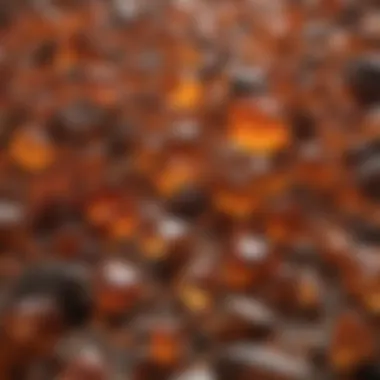

Cleaning Techniques for Crystals
When cleaning brown and orange crystals, it’s essential to adopt methods that do not cause harm or alter their natural state. Here are some effective techniques to consider:
- Gentle Washing: Use lukewarm water and a mild soap solution. Avoid harsh chemicals as they can damage the crystal's surface. A soft cloth or sponge is ideal for wiping away dirt and grime.
- Brush with Care: Sometimes a soft-bristle brush, like a toothbrush, can help in getting to the nooks and crannies. Make sure the brush is dry and gentle to prevent scratching.
- Avoid Ultra-sonic Cleaners: While these devices can clean many types of jewelry, they may not be suitable for all crystals. The vibration could chip or break softer stones.
- Stay Away from Heat: Never place crystals in boiling water or expose them to direct sunlight for extended periods, as temperature fluctuations can lead to cracks or fractures.
Additionally, after cleaning, it's wise to air-dry your crystals completely before storing them. This step helps prevent moisture accumulation, which might cause unwanted alterations like staining or mold growth.
Optimal Storage Conditions
Proper storage conditions are crucial for the longevity of brown and orange crystals. Creating a suitable environment for your crystals not only protects them from physical damage but also preserves their stunning visual qualities.
- Cool and Dry Locations: Store your crystals in a place that remains cool and dry, away from direct sunlight and humidity. Sunlight can fade colors, while humidity can lead to mold formation.
- Individual Containers: Using individual pouches or boxes can help mitigate scratches and chips that may occur when crystals jostle against one another. Consider using fabric pouches or lined boxes.
- Avoid Pressure: Keep your crystals in a place where they won’t be subjected to heavy weights or pressure. Storing crystals on shelves or display cases that are stable and spacious will help prevent accidents.
- Regular Checks: Periodically inspect your crystals for any signs of wear or damage. Catching issues early can often prevent further deterioration.
"Preserving nature’s artworks requires attention to detail, a pinch of love, and a splash of knowledge. Each crystal deserves the best for longevity and beauty."
By employing these conscious care practices, collectors can ensure their brown and orange crystals remain luminous and cherished possessions, showcasing the natural allure they possess.
Collecting Brown and Orange Crystals
Collecting brown and orange crystals is not merely a hobby; it's an exploration of nature's artistry, a journey that unveils the Earth's hidden treasures. For enthusiasts, the allure is multifaceted. These crystals are not just visually striking but also serve various purposes across different cultures and industries. In the throes of collecting, individuals find a deeper connection to the natural world and its geological processes. This section delves into effective strategies for collecting and how to construct a personal crystal collection that stands out.
Strategies for Successful Hunting
When embarking on the hunt for brown and orange crystals, having a clear strategy can make all the difference. Here are some tips to enhance your experience:
- Know Your Locations: Research areas known for their geological formations that yield these hues. Specific locations may include caves, riverbanks, or even construction sites where natural rock formations are exposed.
- Join a Community: Connecting with fellow collectors through local clubs or online platforms can provide insights on where to find rare specimens. Websites like reddit.com can connect collectors across the globe, sharing tips and findings in real-time.
- Use the Right Tools: Equip yourself with essential tools such as a good quality hammer, protective gloves, and a knapsack for carrying finds. A field guide specific to mineral identification can be a valuable asset too.
- Time Your Hunt: Early mornings or late afternoons can yield better finds, especially if you focus on areas where sunlight might reflect off the stones, revealing hidden gems.
- Respect the Rules: Always check local regulations about collecting crystals. Some areas have restrictions to protect natural resources. Ethically sourcing helps sustain the environment for future collectors.
The thrill of unearthing a stunning piece doesn’t just come from luck; it’s about employing well-thought-out strategies.
Building a Personal Collection
Creating a personal collection of brown and orange crystals transcends the mere act of accumulation. It is about curating a showcase that reflects your journey and preferences. Here’s how you can build a collection that's both meaningful and visually appealing:
- Focus on Quality Over Quantity: It’s easy to get caught up in the number of pieces you have. Instead, aim for unique samples that highlight the diversity within brown and orange hues. Each piece should hold a story or a memory.
- Label and Document: As you add to your collection, keep a detailed log of where each piece originated, its characteristics, and any relevant details. This will not only help you remember each stone's history but also add value for future enthusiasts.
- Integrate Display Methods: The way you display your crystals can enhance their appeal. Consider clear display cases, or shadow boxes that highlight their colors. Arrange them by hue or size to create a cohesive look.
- Stay Educated: Read books, attend lectures, or follow experts in the field. The more informed you are about the types of crystals and their significance, the more this knowledge will enrich your collecting experience.
"The joy of collecting is less about what you have and more about the stories behind each piece."
In building your collection, you foster a connection with nature, history, and even art. As you delve into the world of brown and orange crystals, you’ll uncover not just stones, but pieces of Earth’s rich tapestry.
Finale: Embracing the Diversity of Brown and Orange Crystals
The exploration of brown and orange crystals leads us to appreciate the intricacies and diversity found in nature's creations. These colored gems hold profound significance across various spectrums of our lives, from geological rarity to aesthetic charm. As one delves into the depths of these formations, it becomes clear that their appeal extends beyond mere beauty.
First, these crystals are characterized by their unique formations and mineral compositions, offering insights into the Earth’s geological history. The way they formed reveals the environmental conditions at play, serving as monumental records of our planet's past. Furthermore, their colors—ranging from deep umber to brilliant gold—convey both a visual and emotional connection to the earth, as they evoke feelings of warmth and grounding.
Moreover, the cultural significance of brown and orange crystals cannot be overlooked. Throughout history, these crystals have been revered in various societies for their perceived healing properties and spiritual benefits. As we acknowledge their historical importance, we allow ourselves to connect with traditions that honor nature in its rawest form.
"It's not just a collection; it's a legacy of what the Earth offers us."
In practical terms, the uses of these crystals in industries, art, and personal collections showcase their versatility. Whether utilized in manufacturing processes or appreciated as artistic creations, they command attention and respect in numerous arenas. Such versatility opens doors for enthusiasts and collectors to engage with these geological wonders in different ways.
Reflecting on Nature's Creations
Reflecting on nature's creations involves delving into the philosophy behind crystals and their existence. Every crystal tells a story, a narrative shaped by eons of geological processes. Brown and orange crystals, particularly, remind us that beauty often emerges in unexpected places. Their varied colors symbolize stability, warmth, and even the nourishment of the earth.
Additionally, they serve as a bridge between past and present, connecting us to primitive traditions and modern interpretations. The quiet elegance of these rocks may be overlooked amid the glitter of more high-profile minerals, yet they embody a strength and resilience that resonates deeply with earth-loving individuals. As we gaze upon their facets and patterns, we are encouraged to contemplate our own place within the cosmos.
Future Perspectives on Crystal Collecting
Looking ahead, the future of crystal collecting appears vibrant and filled with promise. As awareness grows regarding the mineral world, more collectors are finding joy in unique specimens, particularly brown and orange varieties. There is an increase in community engagement through platforms like Reddit and Facebook, where collectors share insights, hunting tips, and personal stories.
Moreover, technology plays a pivotal role in shaping the landscape of crystal collecting. Access to online databases, educational workshops, and virtual tours of mines allow enthusiasts to expand their knowledge and appreciation further. As collectors focus on ethical sourcing and sustainability, the market is shifting towards responsible practices. People are becoming more discerning about where their crystals come from, emphasizing alignment with ecological and ethical standards.
In sum, as we explore the allure of brown and orange crystals, we not only celebrate their inherent beauty but also acknowledge the potential for growth within the collecting community. The journey of discovering these geological wonders is an ongoing adventure, rich with opportunities for learning and connection.



